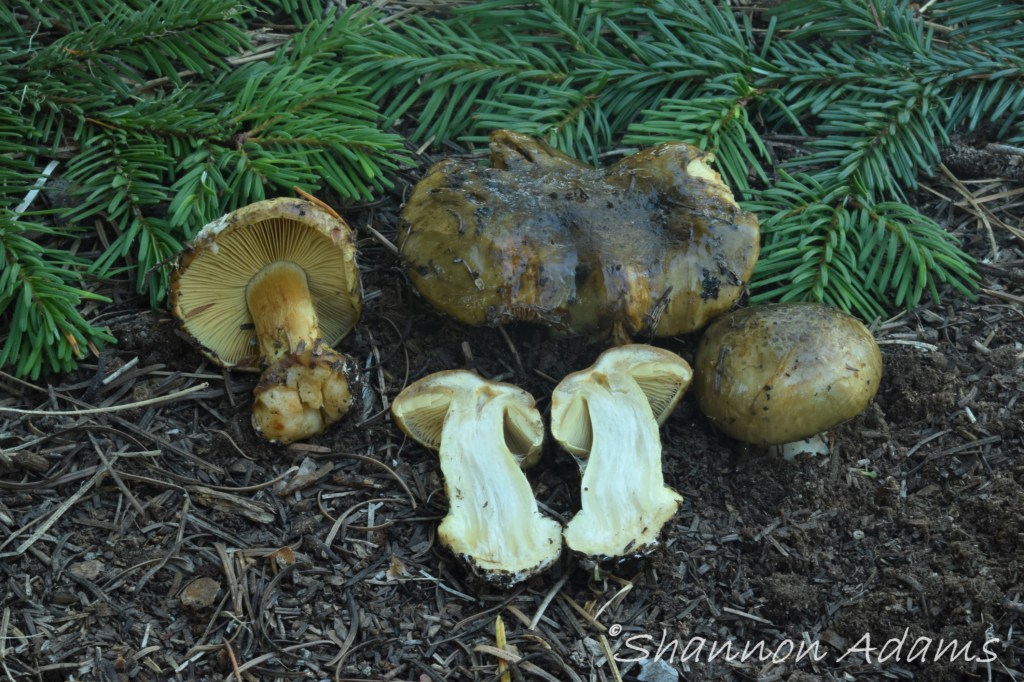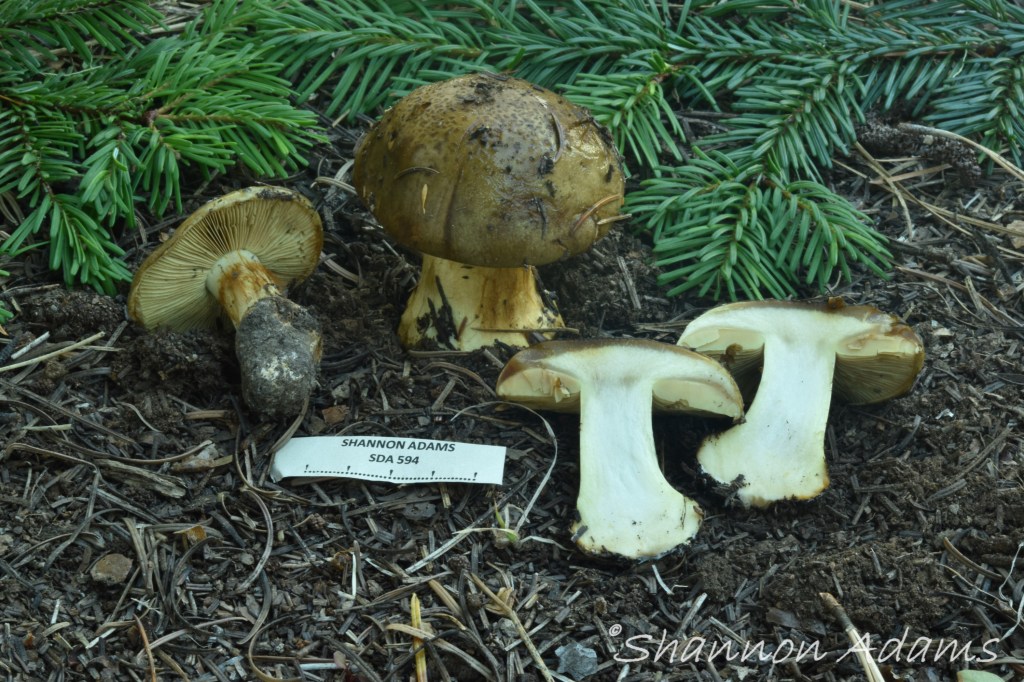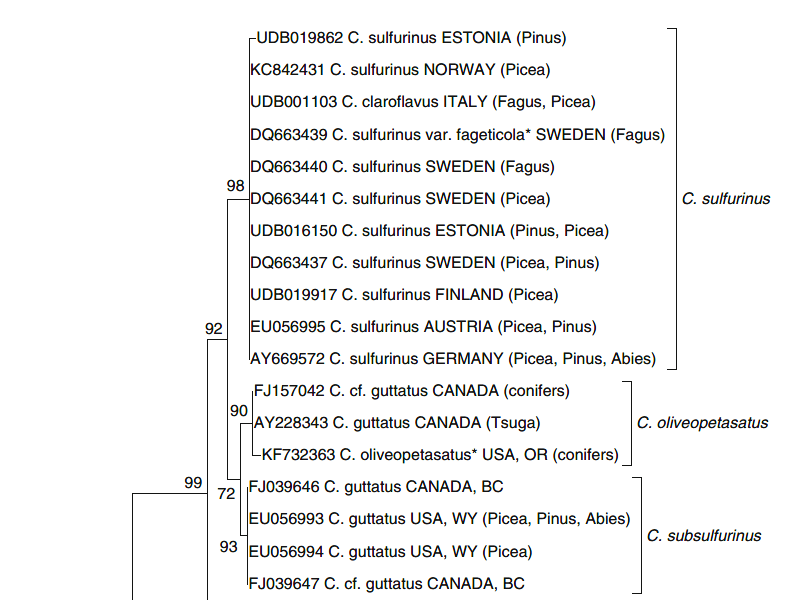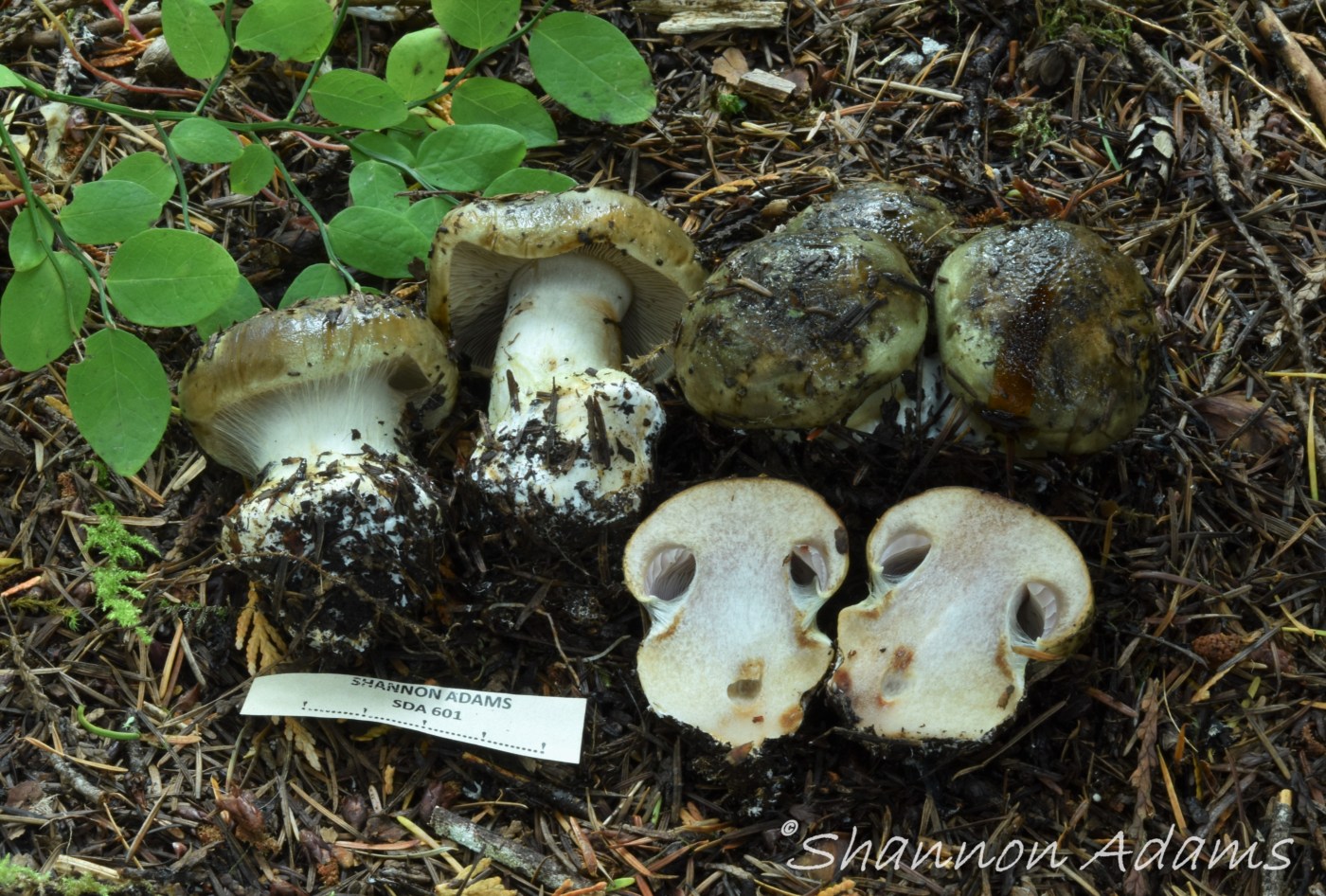Cortinarius oliveopetasatus M.M. Moser, Mycotaxon 74 (1): 29 (2000)
Cortinarius oliveopetasatus one of a few viscid, olive-green to yellow-brown species which is occur in the Pacific Northwest in fall. It is in the Sulfurini clade (a Calochroid) with it’s sister species from our region, Cortinarius subsulfurinus. You may want to look at Cortinarius luteicolor at you make an identification, as it can have similar coloration, although cap cuticle and stature vary.
Description:
Pileus: 35-100 mm across, convex with incurled margin wen young, glutinous, sticky, dark olive-green to olive-brown, with some yellow-green on cap margin, disc somewhat darker with green scales of glutin in center of disc. Lamellae: light buff (when young) to olive-yellow then rusty brown in age. Stipe: 38-100 mm long, 17-25 mm wide at apex, bulbous with small rim, faintly olive-yellow to creamy-buffy, darkening to yellow-brown. Context: Pale straw-yellow in cap and creamy white in stipe flesh. Veil: dull yellow. KOH: Orange-brown on cap and dark brown on stipe. Habitat: Mixed conifer forest.



Discussion:
C. oliveopetasatus is a Phlegmaciod in Section Calochroi within the Sulfurini lineage (Frøslev et al, 2015).

The ITS of sequenced collection (SDA594) is a very close match (678 / 679) base pair match to the barcode Genbank NR_130237.1 – Cortinarius oliveopetasatus IB 19950360 ITS region; from TYPE material, cited in Liimatainen et. al 2014. SDA 601 was collected from the same location as Moser’s Holotype (Mt Hood). According to the description of C.subsulfurinus, the ITS varies by 4 substitutions and one indel.
Cortinarius oliveopetasatus and C.subsulfurinus are very similar. C.oliveopetasatus varies by having dark green instead of pale yellow-green tones. Spores, KOH and even odor are similar (described as like cut-grass or parsely).
Cortinarius luteicolor may also be superficially similar in it’s olive-yellow tones. However, it can be differentiated by the heavy white cortina vs pale-yellow in the Sulfurini, darker fibrils on cap surface vs sticky glutinous patches and KOH which is brick-red on cap and pinkish on stipe-base in C.luteicolor vs brown in C.oliveopetasatus and C.subsulfurini.
>SDA_594
GTAAAGTCGTAACAAGGTTTCCGTAGGTGAACCTGCGGAAGGATCATTATTGAAATTAAACCTGATAAGTTGTTGCTGGTTCTCTAGGGAGCATGTGCACACTTGTCATCTTTGTATTTCCACCTGTGCACTTTTTGTAGACCTGAGTATCTCTCTGAATGCTTAGCCATTCAGGAATGAGGATTGACTTTCAGTCTCTTCCTTACATTTTCAGGTCTATGTTTCTTCATATACCCTATGTATGTTTATAGAGTGTTGTTAATGGGCTTTTGTGCCTATAAACCTATACAACTTTCAGCAACGGATCTCTTGGCTCTCGCATCGATGAAGAACGCAGCGAAATGCGATAAGTAATGTGAATTGCAGAATTCAGTGAATCATCGAATCTTTGAACGCACCTTGCGCTCCTTGGTATTCCGAGGAGCATGCCTGTTTGAGTGTCATTAATATATATCAACCTCTTTGGTTGGATGTGGGTTTGCTGGCCTCTTCAGGTCAGCTCCCCTTAAATGCATTAGCGGACAACATTTTTTGCCAACCGTTCATTGGTGTGATAATTATCTACGCTATTGACGTGAAGCAAGGTTCAGCTTCTAACAGTCCATTGACTTGGACAAATTTCTTTTTATTAATGTGACCTCAAATCAGGTAGGACTACCCGCTGAACTTAAGCATATCAATAAGCGGAGGAAAAGAAACTAACAAGGATTCCCCTAGTAACTGCGAGTGAAGCGGGAAGAGCTCAAATTTAAAATCTGGCAGTCTTTGGCTGTCCGAGTTGTAATCTAGAGAAGCATTATCCGCGCTG
References:
J.F. Ammirati et al., “Cortinarius subsulfurinus sp. nov.” Index Fungorum, no. 551407, (2015)
T.G. Frøslev, Thomas Stjernegaard Jeppesen, and B. Dima, “Cortinarius Koldingensis a New Species of Cortinarius Subgenus Phlegmacium Related to Cortinarius Sulfurinus,” Mycol Progress 14:73 (August 21, 2015)
K. Liimatainen et al., “The Largest Type Study of Agaricales Species to Date: Bringing Identification and Nomenclature of Phlegmacium (Cortinarius) into the DNA Era,” Persoonia : Molecular Phylogeny and Evolution of Fungi 33 (December 2014): 98–140
Moser, M.; Ammirati, J.F. 2000. Studies on North American Cortinarii. VI. New and interesting taxa in subgenus Phlegmacium from the Pacific States of North America. Mycotaxon. 74(1):1-36, Jan-March 2000.

Leave a comment